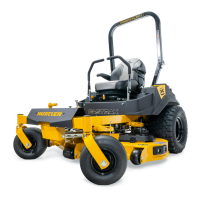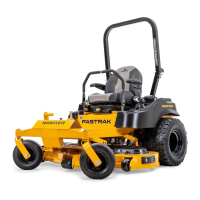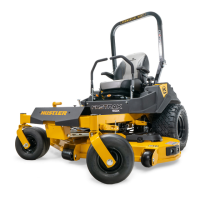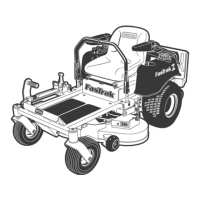605596CE 3-3 REV C
4. Insert the key in the ignition switch and rotate it clock-
wise to engage the starting motor. Release the key
when the engine starts.
IMPORTANT: The engine starter should not be oper-
ated for periods longer than 30 seconds at a time. At
least two minutes between such cranking periods to
protect the starter from overheating and burning-out.
5. Perform the test shown in the Safety Start Interlock Sys-
tem section to make sure the safety start interlock sys-
tem operates properly.
6. Allow the engine to idle two minutes before advancing
the throttle and/or engaging the deck clutch.
Stopping the Engine
Use the following procedure to shut the engine off.
1. Place the steering control levers in the park brake posi-
tion.
2. Throttle the engine back to low idle, then disengage
the deck clutch. Refer to the Mower Deck Operation sec-
tion for more details.
3. Let the engine run at low idle for two minutes.
4. Rotate the ignition key counter-clockwise to the “OFF”
position. Remove the key from the switch before leav-
ing the mower.
Moving the Mower with Stalled Engine
The bypass valves on the transaxles allow the mower to be
moved if the engine quits working.
Before moving the unit, pull out on the bypass valve rod
(
Figure 3-5) until the notch in the rod hooks over the edge of
the slot. This places the bypass valves in the disengaged
position.
Place the steering control levers in the neutral position, to
release the park brakes, so that the mower can be moved.
Do not tow the machine. Move it by hand or use a winch to
load onto a trailer for transporting.
Secure the mower, facing forward, when transporting on
another vehicle. Tie the mower down securely using straps,
chains, cables, or ropes. Both front and rear straps should be
directed down and outward from the machine.
IMPORTANT: Always make certain the two bypass valves
are returned to their operating position before running the
mower following repairs.
ROPS (Roll Over Protective Structure)
A Roll Over Protective Structure (ROPS) and seat belt is
provided with the equipment. Do not remove the ROPS and
seat belt.
A ROPS may minimize the chance of injury or death from
rollover.
A ROPS, when used with a seat belt, is effective in reducing
injuries during unit overturn accidents. Overturning the unit
without a ROPS or without the ROPS locked in the raised
position (
Figure 3-6) can result in serious injury or death.
Pivot the two-post ROPS down by removing the right and
left hair pins (
Figure 3-6), and pulling out on the spring
loaded pins to allow the machine to operate under low hang-
ing tree limbs or other obstructions.
Allow the engine exhaust manifold to cool before
engaging or disengaging the bypass valves. The
bypass valve rods are located close to the exhaust
system.
A. Bypass valve rod B. Transaxle
Figure 3-5
A. ROPS
B. Hair pin
C. Pin
Figure 3-6

